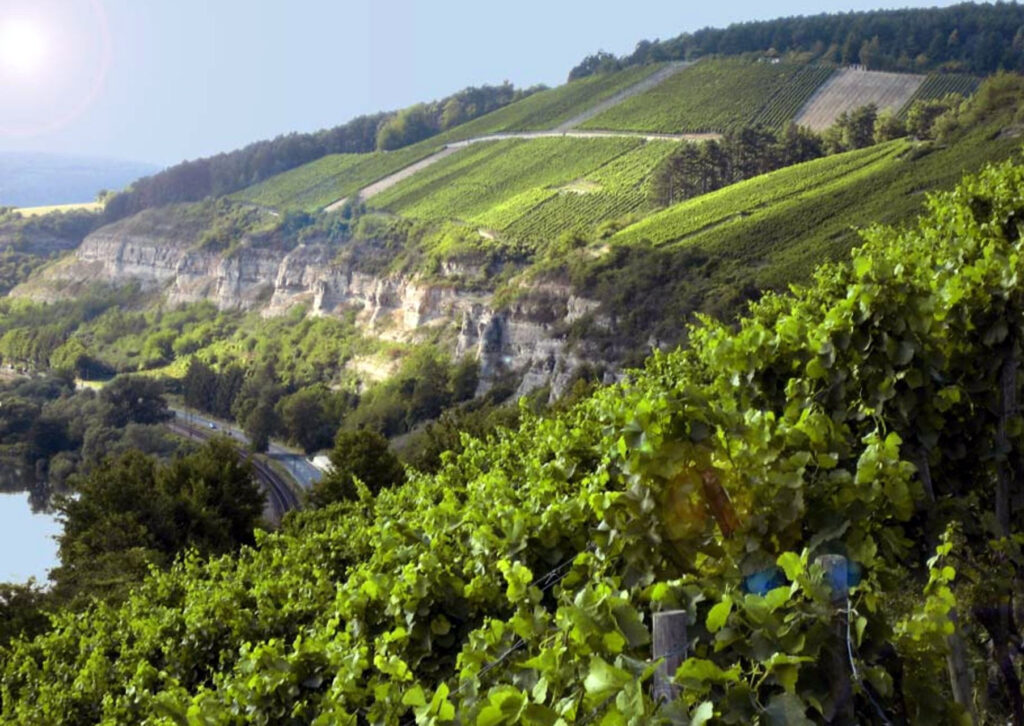With Ludwig Knoll in the Stettener Stein
Standing in the middle of the Stettener Stein, I ask Ludwig Knoll: “What’s the challenge of the future?” His answer: “To build an estate as a farm organism—one that can exist from within itself, through its own efforts—producing its own compost, its own energy, its own water supply.”
“Hardly anyone wants to farm steep slopes anymore. Here in the Stettener Stein we now cultivate about 70 percent of the vines,” says Knoll. “We started small forty years ago and gradually bought or leased more. Today it’s possible to shape this site not only agriculturally but ecologically as well. In the winegrowing belt between Würzburg and the Spessart, truly fully ripe fruit used to be rare; now, in most years, we see heat-driven over-ripeness, and again and again, water stress.”
The challenges in the Stettener Stein are considerable: erosion, thin humus layers, lack of water. Knoll counters them with innovative ideas. “So far we’ve built only one reservoir. On-site energy storage is still a vision for the future,” he explains. “But even now we heat and cool our storage buildings by tapping the heat stored in the ground.”
Energy autonomy also matters. “With solar panels on 2,000 square meters of roof, we’re virtually energy-neutral. Only our tractors still run on fossil fuels.” The reservoirs serve more than resource security: “We’ve designed them to become habitats for fauna and flora.”
Biodiversity as a foundation
A central focus is reviving ecological diversity. “Sheep grazing under natural conditions has proved very effective. Combined with wildflower mixes, we see far fewer pest flare-ups because beneficials are present.” The result is a layered network: “We have to break up monocultures, encourage cover crops, and help build soil humus. Flowering herbs in the inter-rows and along the margins—areas we can leave untouched year-round, create overwintering refuges for insects.”
Knoll sees vineyards as living habitats. “Sand lizards and European green lizards feed on grasshoppers, caterpillars, woodlice, flies, even slow-worms. A broad food web emerges—one that helps sustain wildlife through the winter.”
Opportunity and responsibility
For Knoll, biodiversity is also an economic question. “On the one hand, growers have more and more ways to encourage diversity. On the other, consumers’ desire for sustainable products is growing. But the effort must be reflected in price. If we want biodiversity, society has to value ecological farming accordingly.”
He points to concrete measures such as shrub and woodland strips: “Five to six percent of the area, spaced about every 300 meters and oriented to the prevailing wind—this can cut evaporation in the vineyard by up to ten percent and create biodiversity corridors. Birds and bats find shelter, benefit, and help us by preying on pests.”
The farm organism as the goal
Knoll works closely with Naturland and the regional bird protection association (LBV) and references current best-practice guides. “We have to learn from nature, work in rhythm with it, and understand vineyards as farm organisms. It’s about closing cycles – water, energy, nutrients – while bringing back the diversity of animals and plants into the wine landscape.”
He does not view the vineyard as an isolated production plot but as a living organism shaped by climate, soil, flora and fauna. His work in the Stettener Stein shows that nature-focused viticulture goes far beyond greening and organics: it is an attempt to build closed loops and establish the estate as a self-sustaining organism. In doing so, Knoll not only sets standards in sustainable winegrowing; he also articulates a vision: wine as an expression of a cultural landscape that is ecologically resilient, economically viable, and socially valued.

The Stettener Stein — A natural amphitheater
Anyone stepping into the Stettener Stein for the first time quickly understands why this Franconian site enjoys cult status. The vineyard rises steep and craggy above the unhurried Main River. Experts consider the terroir one of the most compelling in the region, an amphitheater of nature where handwork, dedication, and character play the leading roles.
The finest parcels begin roughly eighty meters above the valley floor. Just above the exposed shell-limestone (Muschelkalk) cliffs, warm air masses rise, creating a unique mesoclimate on the slopes. “The very stony, meager topsoil stores heat and is difficult to root through,” Knoll explains. “That forces the vines, over many years, to drive deep roots into the karstic shell limestone. The result is wines of striking minerality and elegance.”
The numbers tell the story: 50 to 75 percent grades, a vertical drop of around 130 meters, vines rooted in weathered shell limestone. Only over long periods do the plants penetrate the rocky subsoil and access minerals and nutrients.
For Weingut am Stein, the site is a core asset: the VDP.GROSSES GEWÄCHS (GG) wines come from its best parcels. “The Stettener Stein occupies a uniquely top position for us,” says Knoll. “It is our stage for wines that express both the power of the rock and the finesse of the climate.”
Here the site becomes more than a place of production; it is dramaturgy: a semicircular cut in the hillside as backdrop, steep vine rows as tiers, the thermals as an invisible conductor. And the wines carry that staging within them, the clarity of shell limestone, the elegance of deep-rooted vines, and the unmistakable signature of Stettener Stein and of Ludwig Knoll.
– – –
Photo Credit: Ludwig Knoll (© Stefan Bausenwein), Stettener Stein (© VDP)